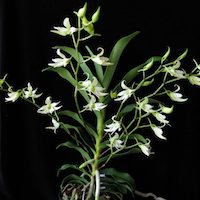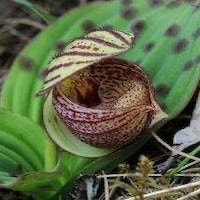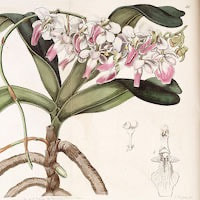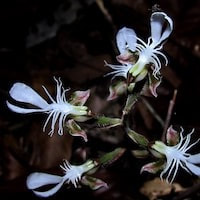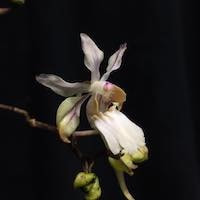Click for other Men's Woody 1, Woody 2, Woody 3, Woody 4, Woody 5, Woody 6, Woody 7, Woody 8, Woody 9, Woody 10, Woody 11, Woody 12
Contains Scented Notes of:
Labdanum - Check details at Scentopia's scent library
Native Singaporean Orchid notes: Sobennikoffia Humbertiana
|
Sobennikoffia Humbertiana - Used in Woody 9 (Men) for Team building Perfume workshop
Relatively rare in Singapore. Found in Madagascar at 400 - 1200 meters growing among rocks in seasonally dry evergreen forests. Morning dew is the main source of water for some of the year. Flowering occurs in April and May, blooms last moderately well. We included this because of its scent and also because of Nparks efforts to understand Orchids of the world. Nparks sent their team around the world where this was one of the flowers studied. https://www.nparks.gov.sg/sbg/research/publications/-/media/sbg/gardenwise/2014-aug-gardenwise-vol-43.pdf The scent is spice with hint of sweet Honeysuckle |
Therapeutic Orchid notes:
|
Smitinandia micrantha (Lindl.) Holtt.
Chinese name: Gai hou lan Thai names: Khem Nu (in Bangkok), Kulap dong (in Ubon Ratchathani) It flowers in May to July in Nepal, April in China, almost year-round in Thailand and April to May in Perlis in northern Peninsular Malaysia. Herbal Usage: In Nepal, powdered plant is mixed with rice flour and butter, then baked, and served as tonic. Leaves are used to treat rheumatism, and juice extracted from the roots is used to treat cuts and wounds. |
|
Cypripedium margaritaceum Franch.
Chinese names: Banyeshao Lan; Chinese medicinal name: Lanhuashuangyecao It grows in deep shade and the leaves are held horizontally across the forest floor. Herbal Usage: It is used to nourish the liver and kidneys. It moderates qi (vital energy) and blood, promotes diuresis and relieves oedema, and improves blurred vision or night blindness. A commonly used folk herb in Yunnan, decoction is prepared by boiling 9–15 g of the herb. |
|
Aerides crispa Lindl.
The generic name, ‘children of the air’, is derived from Greek aer (air) and eides (resembling), referring to its epiphytic nature and the way such orchids are cultivated. A. crispa is a large, tough, robust epiphyte. Young leaves are typically covered with purple spots. Inflorescence is up to 35 cm long, drooping, branching, loosely many-flowered. Ear-drops prepared by boiling the pulverised plant in neem oil, are instilled 2–3 drops at a time into the ear every night to treat earache in the Western Ghats. A. crispa contains aeridin, a bactericidal phenanthropyran. The contribution of aeridin to the management of earache is undetermined, but it works as a bactericide. |
|
Anoectochilus roxburghii (Wall.) Lindl.
Sri Lankan name: Wanna rajah (“that which glistens in the woods”). Taiwanese name:Yaowang (King medicine) This Orchid has dark velvety-green/purplish-red with a complex network of golden veins. This small, terrestrial, jewel orchid thrives in humus rich soil in continental East Asia including China, Vietnam, Laos, Myanmar and also the Himalayan foothills and Sri Lanka. It is a medicinal herb that enjoys widespread provincial usage in Taiwan and Fujian. It is used to treat hepatitis, splenic disorders, hypertension, cancer, tuberculosis, impotence, fever, snake bites and even slow development in children. In Fujian, it is considered to be a panacea for numerous ailments. It is also used in Indian medicines. Several therapeutic compounds have been isolated from this therapeutic orchid. · Zhonghua Bencau Kinsenoside, a glycoside and a major component has anti-glycaemic activity. · Other medicinal compounds are- beta-D-glucopyranosyl-3R)-hydroxybutanolide. · stearic acid · palmitic acid · beta-sitosterol · succinic acid · p-hydroxybenzy-laldehyde, daucosterol, · methyl 4-beta-D- glucopyranosyl-hutanoate, · p-hydroxycinnamic acid · 0-hydroxy phenol · Ferulic acid, · quercetin, · daucosterol, · cirsilineol, · p- hydroxybenzylaldehyde · 2 novel sorghumol triterpenoid acyl esters · a new alkaloid (anoecochine) · and a known triterpenoid (soghumol) |
|
Holcoglossum quasipinifolium (Hayata) Schltr.
Chinese names: Songye Lan (pine leaf orchid), (pine needle orchid), Qiaochun Lan (sledge lip orchid), Caoshe Lan (slot tongue orchid); Yeludongqing (green leaf pine). This semi-terete leaf orchid, once thought to be was endemic in Taiwan, where it occurs invthe Central Mountain Range at 2000–2500 m, often growing on the branches of Quercus. Herbal Usage: The whole plant is used to remove wind and dampness. It causes diuresis and is used for joint pains. It has a broader range of medicinal usage being also used to treat varied infections (malaria, sore throat, mastitis and urinary tract infection) and bleeding disorders (irregular menstruation and traumatic bleeding). |
|
Liparis fargesii Finet
Chinese name: Xiaoyangersuan (small lip sheep ear garlic) Chinese medicinal name: Shimi It is found at 300–1700 m in Southern Gansu, Guizhou, Hubei, Hunan, Shaanxi, Sichuan and Yunnan. The plant is cold-resistant. Herbal Usage: Herb is obtained from Shanxi, Sichuan and Gansu. Entire plant is used in Chi- nese herbal medicine. It benefits the lungs, reduces heat, stops coughs, and is prescribed for tuberculosis, heat coughs and whooping cough. To prepare a decoction, 6–9 g of the dried herb is used at a time |
Other scent notes
Indian sandalwood with bit of spice notes
